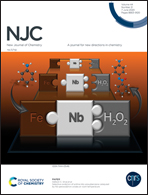Efficiency improvement in non-enzymatic H2O2 detection induced by the simultaneous synthesis of Au and Ag nanoparticles in an RGO/Au/Fe3O4/Ag nanocomposite
Abstract
Developing a quick and precise technique for hydrogen peroxide (H2O2) detection would open up a new class of technologies for biological, medical and chemical applications. Herein, using a polyol method, we report the synthesis of a reduced graphene oxide (RGO)/Au/Fe3O4/Ag nanocomposite with high electrocatalytic efficiency, involving a modified glassy carbon electrode for non-enzymatic trace analysis of H2O2. The resulting nanocomposite showed an inherently high specific surface area and fast electron transfer characteristics of graphene, and Au, Fe3O4 and Ag nanoparticles (NPs). With a detection limit of 1.43 μM at a signal-to-noise ratio of 3 and a response time of 2 s, H2O2 concentrations ranging from 2 μM to 12 mM can be detected by the nanocomposite sensor. By investigating non-enzymatic H2O2 detection in the presence of other biomaterials including ascorbic acid, uric acid, glucose and sucrose, the selectivity of the sensor was evaluated. Furthermore, we test our nanocomposite sensor for practical applications in detection of H2O2, indicating good recoveries for a hair dye cream as a pharmaceutical sample. Our results on the electrocatalytic efficiency of the RGO/Au/Fe3O4/Ag nanocomposite were compared with those of the RGO/Fe3O4 nanocomposite, revealing the role of Au and Ag NPs in the sensing performance improvement.



 Please wait while we load your content...
Please wait while we load your content...